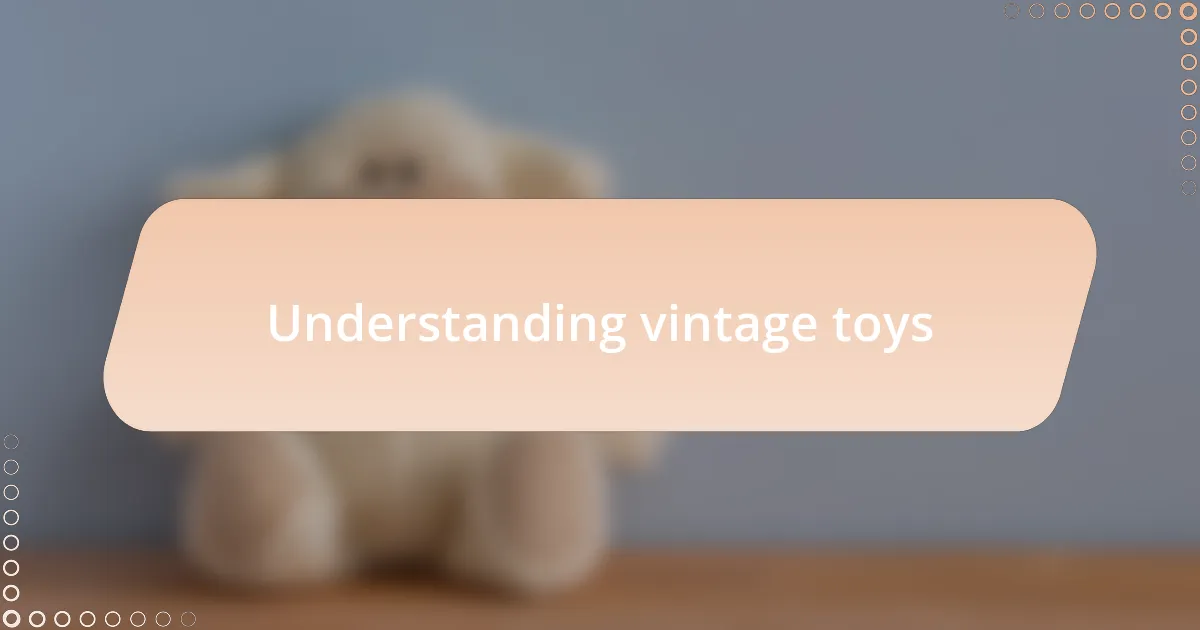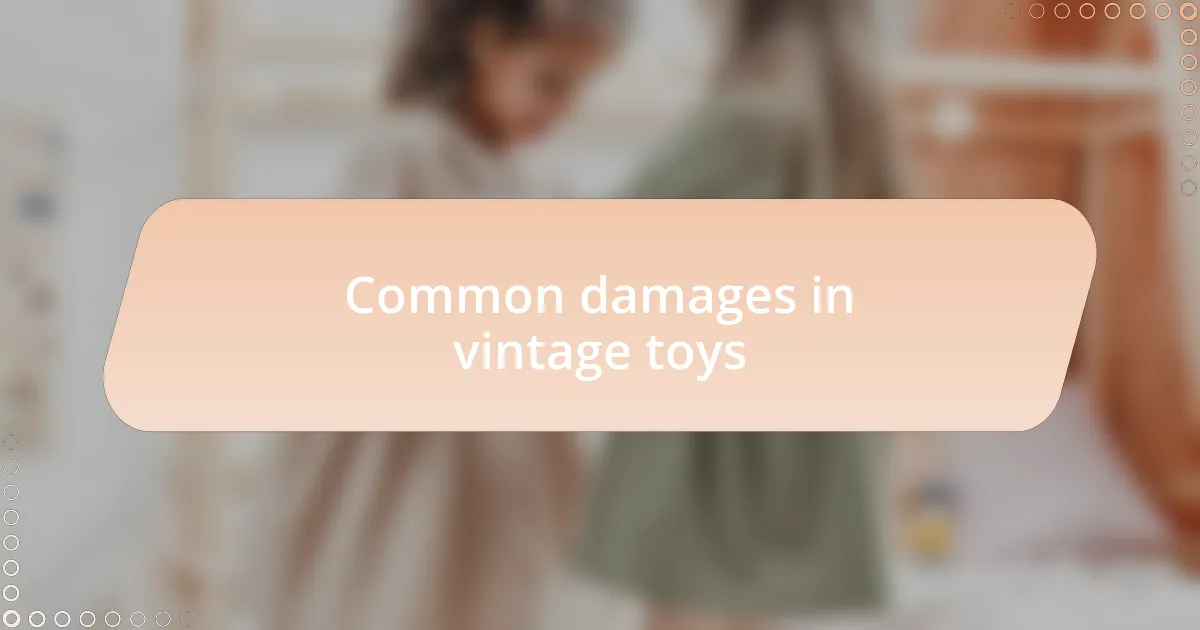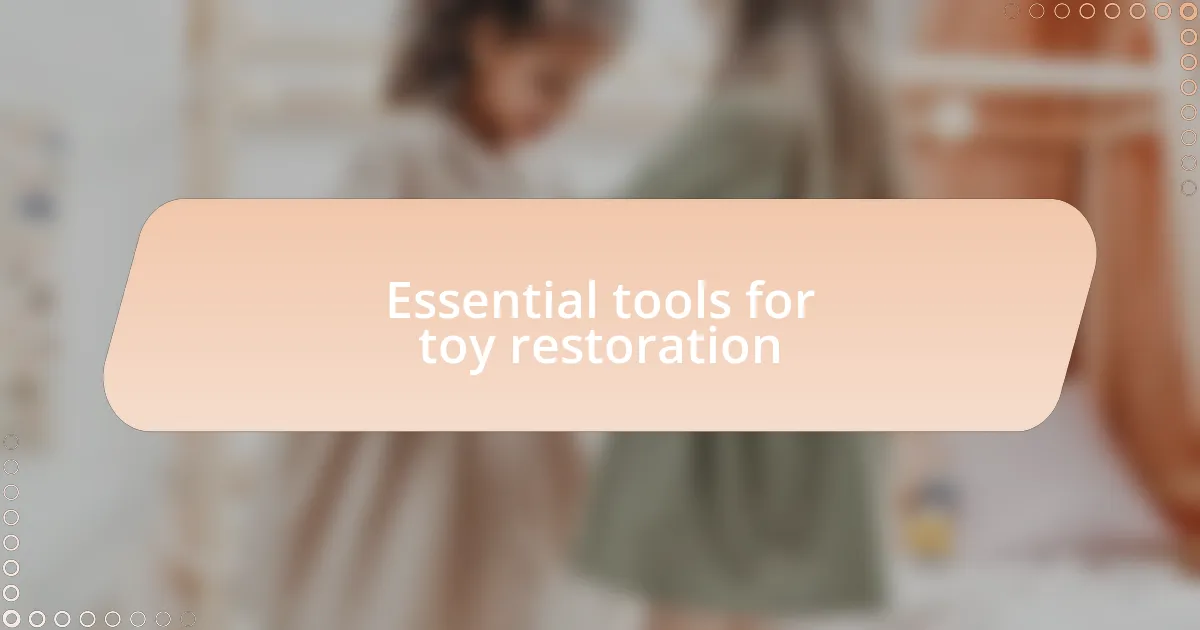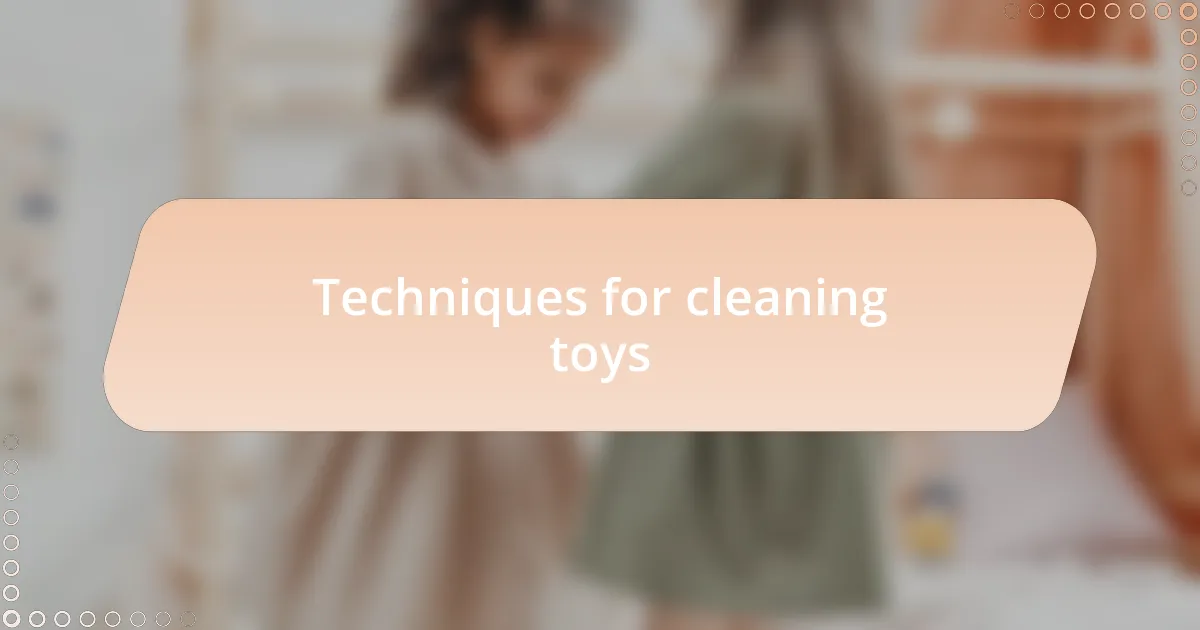Key takeaways:
- Vintage toys evoke nostalgia and tell stories of childhood adventures through their craftsmanship and wear.
- Restoration honors the history of toys, allowing for emotional connections and appreciation for the artistry involved.
- Common damages include faded paint and missing parts, which highlight the need for careful restoration techniques and tools.
- Cleaning and repair methods, such as using acrylic paint and super glue, can revitalize vintage toys and preserve their charm.

Understanding vintage toys
Vintage toys hold a unique charm that often transports us back to simpler times. I remember finding an old tin robot in my grandparents’ attic, the vibrant colors faded but still carrying that unmistakable aura of nostalgia. Isn’t it fascinating how even a simple toy can evoke such vivid memories?
The craftsmanship of vintage toys is another element that captivates collectors and enthusiasts alike. Unlike many mass-produced items today, these toys were often handmade with meticulous detail, reflecting an era when quality was prioritized over quantity. Have you ever held a wooden toy from the 1960s? The weight, the smooth finish, and the craftsmanship speak volumes about the love that went into creating it.
Understanding vintage toys goes beyond their physical attributes; it’s about the stories they tell. Each scuffed surface and faded paint reflects the adventures of children who once played, laughed, and shared moments with them. I once came across a set of marbles that had clearly been cherished, their worn surfaces hinting at countless games played. What stories do you think they could tell if they had a voice?

Importance of toy restoration
Restoring vintage toys is not just about preserving their physical state; it’s about honoring their history. When I restored a weathered plush bear, I was struck by how much care went into its original design. Each stitch and faded patch told a story, reminding me that toys are often witnesses to our childhood experiences. Can you imagine the joy that bear brought to its first owner?
Moreover, toy restoration fosters a deeper appreciation for craftsmanship. I recall meticulously cleaning and polishing a vintage wooden train set. As I worked, I realized that restoring these pieces revives the artistry of a time when toys were intentionally designed to last. How often do we consider the hands that crafted our favorite childhood items?
Additionally, the act of restoring toys can be incredibly therapeutic. My experience with a broken dinosaur figurine taught me that even something seemingly insignificant holds emotional value. As I carefully repaired it, I felt a connection to the child who once cherished it, awakening a sense of nostalgia and joy. Isn’t it incredible how bringing a toy back to life can simultaneously revive cherished memories?

Common damages in vintage toys
When dealing with vintage toys, I often encounter wear and tear that can be disheartening. Common damages include faded paint, scratches, and cracks, which can obscure the toy’s original charm. I remember discovering a once-vibrant tin robot with significant rust spots. It broke my heart a little, but that moment also ignited my passion for restoration.
Another frequent issue I come across is missing parts, which can turn a seemingly complete toy into a puzzle. For instance, finding a vintage action figure that’s missing its weapon or accessory feels like losing a key part of its identity. Doesn’t it make you wonder about the adventures it had and the eagerness of a child who longed to play with it fully?
Finally, I’ve seen countless toys suffer from deterioration due to age, such as brittle plastic or stuck mechanisms. There was a charming wind-up car I loved to tinker with, but its gears had become stiff over the years. It made me appreciate how age can take its toll yet also reminds us of the joy these toys once brought to children. How often do we pause to reflect on the stories behind these beloved items?

Essential tools for toy restoration
When embarking on a toy restoration project, having the right tools is essential. I can’t stress enough the importance of a good set of precision screwdrivers. I once tried to restore a vintage wooden train, and the only tool I had was a giant Phillips head screwdriver. Let me tell you, trying to work with that on tiny screws felt like using a sledgehammer to drive a nail. The right tool can make all the difference in ensuring you don’t strip screws or damage delicate components.
Another invaluable tool in my kit is a soft-bristle brush. I often find dust and grime clinging to toys that have been sitting on shelves for decades. I remember brushing off a dusty teddy bear, and as I carefully cleaned it, I uncovered the most beautiful embroidery. That soft bristle brush brought back to life not just the bear but also the memories attached to it. Have you ever found hidden treasures just beneath the surface while restoring?
Lastly, a quality adhesive is a game changer when it comes to fixing fractures or reattaching broken parts. I had a near-miraculous moment when I managed to bond a broken arm on a ceramic figurine. It was nerve-wracking at first, but once the adhesive set, I couldn’t help but feel a surge of satisfaction. What’s more rewarding than witnessing something thought to be lost rekindle its former glory?

Techniques for cleaning toys
Cleaning vintage toys requires a gentle touch and the right approach. One of my go-to techniques is using warm, soapy water for plastic toys. I remember the first time I soaked a long-neglected action figure in a mild detergent solution. It was almost like watching a time-lapse transformation, revealing vibrant colors I hadn’t seen in years. Just be careful not to submerge any electronic or battery-operated pieces; water and electronics don’t mix well!
For plush toys, I’ve found that spot cleaning works wonders. I typically use a damp cloth with a bit of fabric cleaner to tackle stains while avoiding soaking the entire toy. There was a time I cleaned a vintage stuffed animal that had seen better days—the difference was astounding! The joy of seeing that beloved friend regain its bright eyes and fluffy texture almost felt like reuniting with an old friend.
Lastly, using a vacuum cleaner with a soft brush attachment is a fantastic way to clean toys without harming delicate surfaces. I recall using this technique on a vintage dollhouse, where dust had settled into every nook and cranny. A gentle vacuum session made clean-up a breeze, and I was left with a sense of accomplishment knowing I had preserved its charm while keeping it pristine. What tool do you think you’d want to incorporate into your cleaning routine?

Repair methods for broken parts
When it comes to repairing broken parts of vintage toys, I often lean towards super glue for small fractures. I vividly remember a cherished toy car from my childhood with a shattered wheel. With precision and care, I applied a drop of glue, watching it mend right before my eyes. It was gratifying to see a piece of my past come back to life—what do you think it would feel like to hold a repaired toy that once seemed beyond saving?
For more substantial breaks, I’ve found that epoxy resin works wonders. There was a time when I painstakingly rebuilt a vintage robot’s arm that had completely detached. Mixing the resin and hardener was a bit of a science experiment, but the end result was worth it. The durability and strength offered by epoxy brought that little robot back into action, and it felt like reclaiming a part of history.
Sometimes, I resort to creative solutions like using screws or pins to reinforce weak points on toys. I remember fixing a classic wooden puzzle where the pieces had become loose over the years. I carefully replaced the worn-out dowels with new ones, reinforcing the structure while keeping its vintage charm. It was a simple fix, but the satisfaction of enhancing its longevity made me wonder: how many more toys could benefit from a little ingenuity?

Personal favorite techniques for restoration
One of my go-to techniques for restoring the paint on vintage toys is using acrylic paint and a fine brush. I recall working on a tin robot that had seen better days, its colors fading significantly. With a steady hand and a keen eye, I carefully touched up the chipped areas, and it was like breathing new life into the toy. Have you ever experienced that moment when a little color transforms something old into something magnificent again?
For toys with decals, I often turn to printed water slide transfers. I remember a delightful little wind-up monkey from the 1960s that had lost its original pattern over time. I sourced a replica decal and delicately applied it, ensuring it aligned perfectly. The moment I saw it restored to its former glory, I couldn’t help but smile. Isn’t it amazing how even the smallest details can make a significant impact on the overall appearance?
Sometimes, I use wax to bring back the shine on vintage plastic toys. After cleaning a classic action figure, I applied a bit of carnauba wax for a subtle luster. It was a nostalgic feeling; this figure, once dull and lifeless, now gleamed on my shelf like a treasured relic. Have you ever considered how a little wax can unlock the full potential of a toy’s charm?